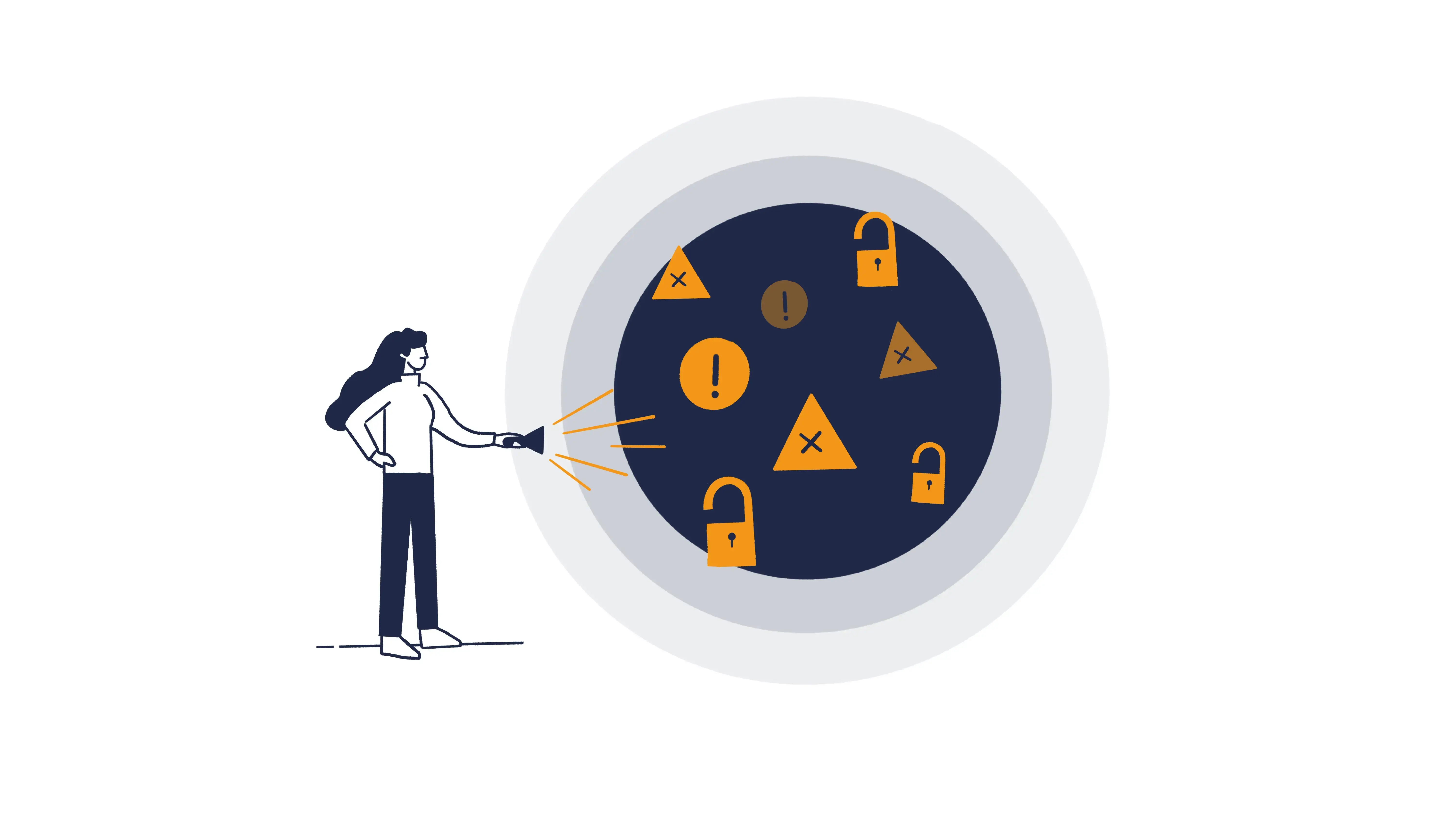Looking to understand what is MDR? Managed Detection and Response (MDR) is a cybersecurity service that combines technology and human expertise to detect, analyse, and respond to cyber threats and security events in real time. This article will break down what MDR entails, how it works, and its benefits for mid-sized organisations.
MDR in a nutshell:
- Managed Detection and Response (MDR) services combine advanced technologies and human expertise to provide real-time threat detection and incident response, ensuring business continuity.
- MDR offers around-the-clock monitoring through a Security Operations Center (SOC). It reduces the burden placed on internal IT teams and allows companies to focus on strategic security initiatives.
- The top MDR providers offer a mixture of expertise, integration capabilities, and transparent pricing models, ensuring comprehensive protection and effective threat management.
What is Managed Detection and Response (MDR)?
Managed Detection and Response (MDR) refers to a form of outsourced cybersecurity services that protects companies from cyber events through proactive threat detection and incident response. MDR services monitor security events 24/7, integrating advanced technologies and human expertise to detect, analyse, and respond to security alerts in real time, minimising the impact of cyberattacks and ensuring business continuity.
Utilising technologies such as Endpoint Detection and Response (EDR), Security Information and Event Management (SIEM), or Extended Detection and Response (XDR), MDR services go beyond threat detection and response capabilities. Leveraging threat intelligence, MDR solutions offer insights into current and emerging threats, enhancing security operations and helping organisations maintain brand reputation and customer trust.
What is the role of MDR in modern cybersecurity?
Managed Detection and Response (MDR) services empower companies to detect and respond to advanced threats in real-time, maintaining a proactive approach to security, and leveraging advanced threat intelligence and human expertise to stay ahead.
MDR services are especially valuable to companies that lack the resources or expertise to manage their own security operations. By outsourcing to an MDR provider, these companies gain access to continuous security monitoring and expert analysis, ensuring that threats are identified and mitigated promptly.
A brief history of MDR
The evolution of Managed Detection and Response (MDR) can be traced back to traditional managed security services. As cyber threats grew more sophisticated, there was a pressing need for more proactive threat detection and response capabilities. Early MDR services primarily focused on monitoring and alerting, providing companies with basic insights into potential security issues.
In recent years, as the threat landscape became increasingly complex, MDR services evolved to incorporate more advanced tools, threat intelligence, and human expertise. This shift was driven by the need to address advanced threats that traditional security measures could not effectively manage. Today, MDR services combine cutting-edge technologies with skilled analysts to detect, analyse, and respond to cyber threats in real-time, 24/7. This evolution has made MDR an indispensable component of modern cybersecurity, providing companies with the tools and expertise needed to defend against increasingly sophisticated attacks.
How does MDR work?
MDR providers monitor security events using a combination of advanced technologies and threat intelligence to detect and respond to sophisticated cyber threats effectively. These technologies typically include SIEM, EDR, and Endpoint Protection Platforms (EPP), which collectively enhance the overall effectiveness of MDR solutions. Continuous cybersecurity monitoring ensures that threats are detected and addressed swiftly, providing organisations with around-the-clock protection.
The MDR process involves real-time threat monitoring, rapid incident response, and the implementation of necessary configuration changes to counter evolving attacks. Prioritising threats based on real-time data ensures that significant cyber threats are addressed promptly and affected endpoints are restored.
Here is how proactive protection works in five steps
MDR services achieve proactive protection via a structured five-step process:
- Threat Detection and Response (TDR). Utilising advanced technologies and threat intelligence, MDR services continuously monitor for suspicious activities and respond to threats in real time.
- Threat hunting. Security experts actively search for advanced threats that may have evaded initial detection, leveraging their expertise to identify and neutralise potential risks.
- Incident response. In the event of a security incident, MDR services provide rapid identification, containment, and eradication of threats, minimising the impact.
- Cybersecurity monitoring. Continuous monitoring of the organisation’s IT environment ensures that any anomalies or potential threats are detected and addressed promptly.
- Continuous threat analysis. Ongoing analysis of threat data helps to refine detection capabilities and improve the overall security posture.
This comprehensive approach, combining advanced threat intelligence and human expertise, enables organisations to respond quickly to security incidents and minimise the risk of breaches.
What is the role of the 24/7 Security Operations Center (SOC)?
The Security Operations Center (SOC) serves as the command center for MDR, overseeing the monitoring, detection, and response to security threats. Staffed by security analysts, the SOC operates around the clock, ensuring continuous vigilance against potential threats. The SOC’s role is maintaining an organisation’s security posture by providing real-time 24/7 threat monitoring and detection and coordinating incident response efforts.
Communication between the MDR provider and the organisation is facilitated through a central communication hub, ensuring that stakeholders are promptly informed about security incidents and the steps being taken to address them.
What are the key benefits of MDR?
MDR services offer cost-effective protection that allows organsations to enhance their security without adding significant tools or personnel. Continuous monitoring of security events helps in the proactive identification and mitigation of cyber threats. By leveraging both technology and human analysts, MDR services boost threat detection capabilities, ensuring proactive identification and mitigation of cyber threats.
Around-the-clock coverage
One of the primary benefits of MDR is around-the-clock coverage, which ensures continuous monitoring of security events for suspicious or unknown threats and anomalous activities. This 24/7 vigilance reduces the time attackers have to cause harm. The Security Operations Center (SOC) plays a crucial role in this continuous protection, with skilled analysts monitoring and responding to threats at all times.
Filtering and prioritising alerts reduces alert fatigue, allowing security teams to focus on actionable intelligence and significant threats.
Enhanced compliance
Integrating managed detection and response services significantly enhance compliance with industry regulations. Advanced analytics, machine learning, and automated response capabilities within MDR services contribute to improved compliance by providing data-driven insights that help organisations meet specific regulatory requirements, ensuring that they avoid potential penalties. Access to compliance experts through MDR, most recently in the shape of a vCISO or a virtual CISO, can bring in the necessary guidance to adhere to industry standards.
Decreased IT burden
Outsourcing to MDR providers allows internal IT teams to concentrate on strategic security initiatives rather than being bogged down by day-to-day security monitoring and incident response. This reduction in workload and expense of staffing an internal security team is one of the key benefits of MDR services. Organisations gain continuous access to cybersecurity expertise without the need for additional hires, making MDR a cost-effective solution.
MDR services are particularly valuable for organisations facing talent shortages as they provide access to skilled security professionals who manage and prioritise threats effectively.
Overcoming alert fatigue with MDR
Security teams are often overwhelmed by a high volume of false positives. Managed Detection and Response (MDR) services address this by leveraging advanced threat intelligence and human expertise to filter out false positives and prioritise real threats.
MDR services utilise machine learning techniques to analyse and categorise security alerts themselves, ensuring that only legitimate threats are escalated to security teams. MDR analysts review and investigate these alerts, providing a second layer of scrutiny to confirm the validity of potential threats. By reducing the number of false positives and focusing on genuine security incidents, MDR services help security teams to concentrate on the most critical threats.
What types of MDR services are out there?
MDR services encompass a variety of categories, including continuous monitoring, proactive threat hunting, managed investigation and response, and security posture optimisation. Continuous monitoring ensures that organisations are constantly protected against emerging threats by tracking security events to detect emerging threats, whereas proactive threat hunting involves actively seeking out advanced threats before they can cause harm.
Managed investigation and response services provide rapid identification behavioral analysis, containment, and eradication of security incidents. Security posture optimisation focuses on continually improving security measures to enhance overall cyber resilience.
How is MDR different from other cybersecurity solutions?
MDR stands out from other cybersecurity solutions due to its managed service model, which combines human-led expertise with advanced security tools and data management. Unlike traditional security solutions that may focus solely on technology, MDR provides active threat response and comprehensive security coverage, making it a more holistic approach.
The integration of human expertise in MDR services ensures that threats are not only detected but also effectively managed and mitigated, leading to significant cost savings and enhanced security.
MDR vs. EDR
While Endpoint Detection and Response (EDR) tools mostly track behaviors and respond to cyber threats using automation, MDR enhances endpoint security by integrating EDR capabilities with a dedicated endpoint security team for comprehensive threat management. EDR tools, although effective, can be resource-intensive and require specialised skills to operate.
MDR services leverage EDR technology for enhanced security but go beyond by incorporating human expertise and mature processes to manage and respond to threats effectively.
MDR vs. XDR
Extended Detection and Response (XDR) integrates data from various sources for improved visibility across multiple security layers. However, XDR tools as such do not necessarily involve a team of human analysts to manage complex threats themselves, which can be a limitation.
XDR is offered as a software as a service (SaaS) solution, emphasising streamlined visibility and integration across security measures. While XDR provides a consolidated view of threats, it can present integration challenges for early-stage organisations and may require connections with disparate tools.
MDR vs. MSSP
Managed Security Service Providers (MSSPs) primarily focus on the operational management of security tools and alerting rather than actively responding to threats. In contrast, advanced MDR providers conduct additional operations such as threat hunting, making them more proactive in managing cybersecurity threats.
Broadly, active threat response and comprehensive security coverage make MDR services a more robust solution compared to MSSPs. However, some modern MSSPs blur the line by integrating MDR-like features, such as SOC-as-a-Service or basic threat hunting, especially if they market themselves as “next-gen MSSPs.” At the same time, MDR services may also vary as not all offer deep incident response or forensics unless explicitly stated.
How to choose the right MDR provider?
Choosing the right MDR provider involves considering factors such as expertise, service range, flexibility, technology strength, and level of service. Organisations may face challenges in-house, such as size, budget, and specific security needs, which can influence their decision to partner with an MDR provider.
A structured transition plan is needed for successfully implementing MDR services, detailing steps, timelines, and resources required. MDR services also offer scalability, adapting to an organisation’s evolving security needs while providing a range of options including MDR, MEDR, MNDR, or MXDR.
Evaluating provider expertise
An MDR provider should offer services such as threat hunting, incident response, endpoint detection, and threat intelligence, utilising advanced technologies like EDR and SIEM to enhance security measures.
The provider’s ability to manage and respond to threats effectively, combined with access to skilled cybersecurity analysts and advanced security technologies, ensures that organisations can maintain a robust security posture.
Integration with existing security tools
Seamless integration with existing security tools is needed for consolidating visibility and ensuring effective threat management. MDR services should be able to work with an organisation’s existing security infrastructure, enhancing their security operations and providing comprehensive protection against potential threats.
Integrating with existing tools ensures that MDR services provide security teams with a unified view of the threat landscape, enabling more effective responses to sophisticated threats.
Cost and service predictability
Transparent pricing models and knowing the potential costs upfront enables better financial planning and cost management, ensuring that organisations can allocate resources efficiently.
Outsourcing to an MDR provider also reduces the workload on IT staff, allowing them to focus on strategic projects rather than day-to-day security monitoring and incident response.
Taking things to the next level: Managed Extended Detection and Response (MXDR)
Managed Extended Detection and Response services (MXDR) represent an advanced evolution of traditional MDR services. Delivered as a service by an external team, MXDR provides comprehensive coverage, real-time monitoring, and enhanced cyberthreat hunting capabilities. It extends protection across various IT environments, offering faster and more effective services compared to traditional MDR.
MXDR, often referred to as XDR as a service, combines advanced detection and response capabilities with human expertise to deliver robust cybersecurity solutions. The Managed XDR service can monitor businesses within hours of deployment, providing 24/7 security operations and ensuring continuous protection against advanced threats. This next-level service helps organisations stay ahead of even the most sophisticated cyber threats, maintaining a strong security posture at all times.
How does cyber insurance enhance an MDR solution?
Cyber insurance supplements and enhances managed detection and response (MDR) solutions. As cyber threats become more prevalent, insurers are encouraging businesses to adopt MDR services to bolster their protection and enable insurability. The integration of MDR services can significantly enhance an organisation’s cyber resilience, making them more attractive to insurers and potentially leading to premium discounts.
Implementing MDR services demonstrates a proactive approach to cybersecurity, which is highly valued by cyber insurance providers. This way, cyber insurance and MDR solutions work together to provide comprehensive protection.
Conclusion
Managed Detection and Response (MDR) services offer a comprehensive solution to the complex and evolving landscape of cybersecurity threats. By combining advanced technologies with human expertise, MDR provides continuous monitoring, proactive threat hunting, and rapid incident response, ensuring that organisations can maintain strong security postures. The integration of MDR services enhances compliance, reduces the IT burden, and offers cost-effective protection solutions.
As organisations face increasing cyber threats, choosing the right MDR provider becomes crucial. Evaluating provider expertise, ensuring seamless integration with existing security tools, and considering cost and service predictability are essential steps in this process. Additionally, advancements such as Managed Extended Detection and Response (MXDR) and the synergy with cyber insurance further enhance the effectiveness of MDR solutions.
Frequently Asked Questions
What is Managed Detection and Response (MDR)?
Managed Detection and Response (MDR) is an outsourced cybersecurity service that leverages advanced technologies along with human expertise to actively detect, analyse, and respond to security threats, thereby ensuring business continuity and reducing the impact of cyberattacks.
How does MDR differ from EDR?
MDR differs from EDR by providing a more comprehensive security approach that combines EDR capabilities with the expertise of a dedicated security team for enhanced threat management. This integration allows for proactive monitoring and automated response to cyber threats beyond what EDR alone can offer.
What are the key benefits of MDR services?
MDR services provide around-the-clock coverage and continuous access to cybersecurity expertise, enhancing compliance with industry regulations while reducing the IT burden. These services also offer cost-effective protection.
How can I choose the right MDR provider?
To choose the right MDR provider, evaluate their expertise, ensure compatibility with your existing security tools and systems, consider their cost and predictability of services, and select one that offers scalable solutions tailored to your specific needs. This comprehensive approach will help ensure your security needs are effectively met.
What is the role of the 24/7 Security Operations Center (SOC) in MDR?
The 24/7 Security Operations Center (SOC) monitors, detects, and responds to security threats in real time. A team of skilled security analysts ensures continuous vigilance.




